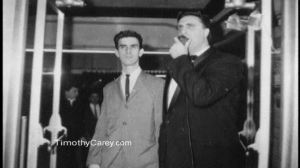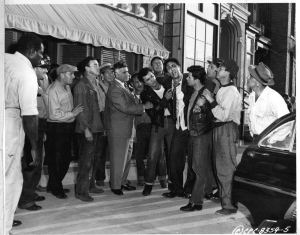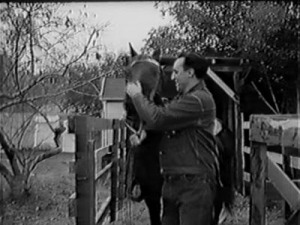Zappa still thought that the best way to get his music played was to write film scores and in June 1961 another opportunity presented itself: The World’s Greatest Sinner, one of the most eccentric (rather than experimental) films ever made. It was an independent movie produced, directed, written and starring the great character actor Timothy Carey – ‘the ugliest man alive’ – veteran of bit parts in everything from The Wild One (1954), where he throws beer in Brando’s face; East of Eden (1955); The Killing (1956) and Paths of Glory (1957). Brando liked him and used him in One-Eyed Jacks (1961). Frank always enjoyed Carey’s films, though he preferred the weird crazed ones like Rumble On the Docks (1956), a juvenile delinquent movie.
Frank met Timothy Carey at Wallach’s Music City in Hollywood while he was working on The Second Time Around, a western comedy. ‘A fellow came up to me and complemented me on my acting,’ recalled Carey. ‘He said he was a composer and the guy he came with, his next-door neighbour, played the guitar. I said, “What’s your name?” He said, “Frank Zappa.” So I said, “OK, I have something for you. We have no music for The World’s Greatest Sinner. If you can supply the orchestra and a place to tape it, you have the job.” And that’s what he did.’
The World’s Greatest Sinner is the story of a dissatisfied middle-aged insurance clerk named Clarence Hilliard who wakes up one day and decides that he is God: ‘We should be Gods, every one of us here, super human beings!’ He starts his own church, gets a guitar and fake goatee, acquires an Elvis Presley silver lame’ suit and works his audiences into a frenzy with wild, furious, rock ‘n’ roll shows, throwing himself around the stage, flopping about on his back as if he were having an epileptic fit and diving into the audience. He runs for President, has sex with 14-year-old groupies, seduces an 80-year-old woman for her money and drives a man to suicide. This disjointed, totally anarchic film uses flash forwards, upside down shots, breaks into full colour at the end and is narrated by the Devil, represented by a stentorian-voiced boa-constrictor. Just Zappa’s sort of film. Carey began work on it in 1958, shooting most of the scenes in his garage in El Monte. It cost $100,000 in total. […]
…In March [1962] Zappa was interviewed by the Pomona Progress-Bulletin about The World’s Greatest Sinner. Under the headline ONTARIO MAN WRITES SCORE FOR NEW FILM the paper described Tim Carey as ‘Hollywood’s “ugliest, meanest” character actor’ and revealed that Zappa played guitar, drums, piano and vibraphone. Zappa described the film as ‘arty’ and said, intriguingly, ‘The score is unique in that it uses every type of music.’ […]
His performance [on The Steve Allen Show on March 14, 1963] certainly irritated Timothy Carey whose movie had premiered six weeks before. Carey: ‘That’s where our friendship stopped. Steve asked him what films he did. He said he did The World’s Greatest Sinner, the world’s worst film, and all the actors were from skid row. It wasn’t true.’ Carey said that Frank was just saying that to curry favour. He described how on the opening night at the Directors’ Guild, Frank had been in such awe of his surroundings he walked into a window and banged his head. At the premiere at the Vista-Continental Theater in Hollywood on 30 January 1963, Carey, ever the showman, appeared in his silver lame’ preacher suit with GOD stitched on the sleeves and got the evening off to an exciting start by firing a .38 over the heads of the audience.
– Barry Miles, Zappa: A Biography (Grove Press, 2004)









